Sun Hung Kai Properties Bundle
How Did Sun Hung Kai Properties Shape Hong Kong's Skyline?
Dive into the compelling Sun Hung Kai Properties SWOT Analysis to understand the strategic moves of a real estate giant! From its inception in 1972, Sun Hung Kai Properties (SHKP) has been synonymous with innovation and quality in Hong Kong's property market. Explore the fascinating journey of SHKP, a company that has consistently redefined urban living and commercial spaces.
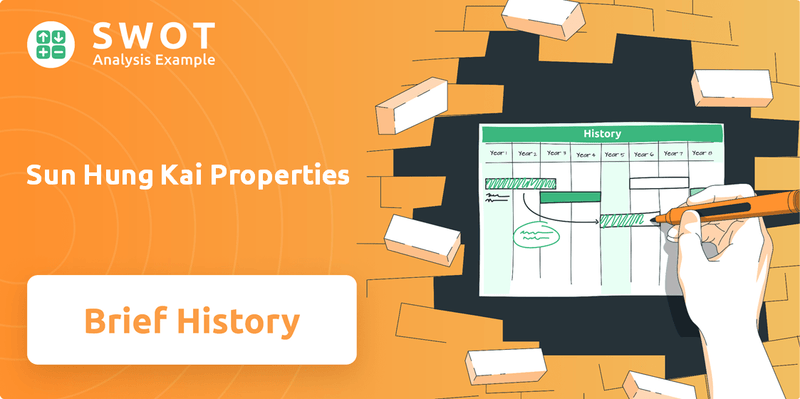
This article delves into the rich Sun Hung Kai history, tracing its evolution from a local developer to a global powerhouse. Learn about the Kwok family's influence and the company's impact on Hong Kong real estate. Discover how SHKP's strategic foresight and commitment to excellence have solidified its position as a leader in property development, making it a key player in the financial landscape.
What is the Sun Hung Kai Properties Founding Story?
The story of Sun Hung Kai Properties (SHKP) began on July 14, 1972, marking the official establishment of a company with deep roots in Hong Kong's burgeoning real estate market. The founding of Sun Hung Kai Properties was a pivotal moment, shaped by the vision of three key figures who saw an opportunity to address the city's growing housing needs.
The founders, Kwok Tak-seng, Lee Shau-kee, and Fung King-hey, brought together a diverse set of skills and experiences. Kwok, with his textiles background, understood the importance of providing accessible housing. Lee, already a successful property developer, offered his expertise in real estate and finance. Fung, the financier, contributed crucial capital and financial acumen. Their combined strengths formed the bedrock upon which Sun Hung Kai Properties was built.
The company's early years were defined by a focus on mass-market housing, a direct response to the post-war housing shortage and the economic boom in Hong Kong. Their business model revolved around land acquisition, property development, and sales, targeting the middle class. This approach, coupled with strategic partnerships, enabled them to secure prime land parcels and launch their initial projects.
Sun Hung Kai Properties' founding was a response to Hong Kong's post-war housing shortage and economic growth.
- The company was officially established on July 14, 1972.
- The founders included Kwok Tak-seng, Lee Shau-kee, and Fung King-hey.
- Their initial focus was on developing mass-market housing.
- Initial funding came from personal capital and partnerships with local banks.
The founders of Sun Hung Kai Properties identified a significant need in Hong Kong: affordable and quality housing. This vision was realized during a period of rapid industrialization and population growth, which created a strong demand for residential properties. Their strategy involved acquiring land, developing residential units, and selling them to the public. The synergy among the founders, despite their varied backgrounds, was key to their early success. Capital for the initial projects came from a combination of their own funds and strategic alliances with local banks, which helped them secure prime land for development. The economic and cultural context of Hong Kong in the 1960s and early 1970s, marked by fast economic expansion and urbanization, provided a favorable environment for property development. For more details, you can read about the Growth Strategy of Sun Hung Kai Properties.
Sun Hung Kai Properties SWOT Analysis
- Complete SWOT Breakdown
- Fully Customizable
- Editable in Excel & Word
- Professional Formatting
- Investor-Ready Format
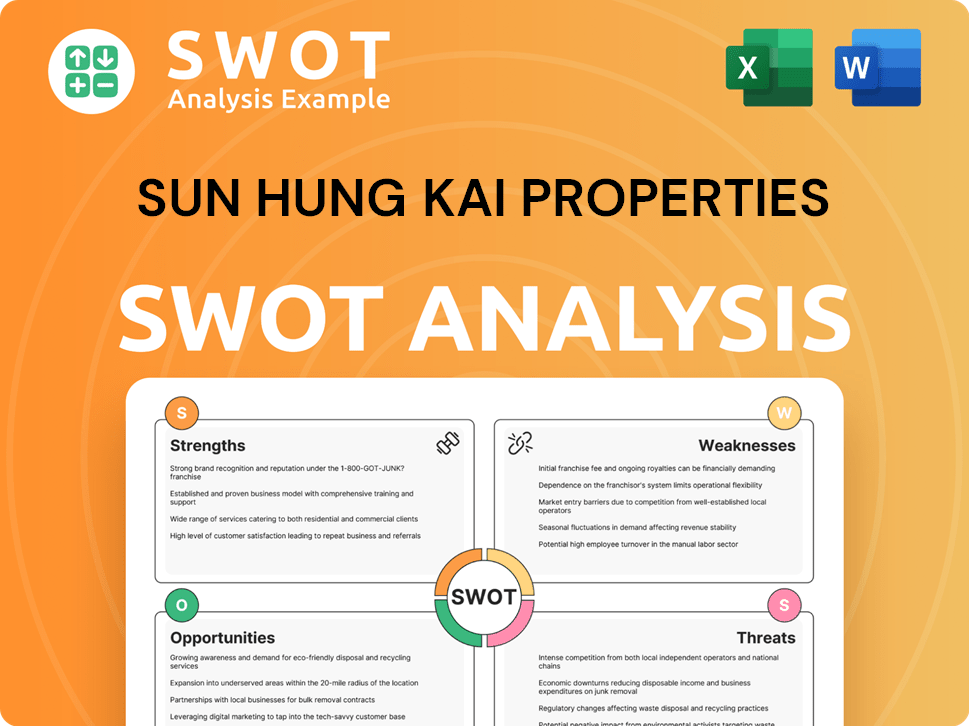
What Drove the Early Growth of Sun Hung Kai Properties?
The early years of Sun Hung Kai Properties (SHKP) were marked by rapid growth and expansion. Following its establishment, the company focused on residential estates, quickly gaining a reputation for quality construction and timely delivery. These initial successes enabled SHKP to expand its land bank and project pipeline significantly. The company also began to diversify into commercial property development.
SHKP's initial strategy centered on residential projects to meet the growing housing demand in Hong Kong. Early product launches included mass-market residential projects. This focus allowed SHKP to establish a strong foundation in the Hong Kong real estate market. The company's early projects set the stage for its future success.
A significant milestone was the company's listing on the Hong Kong Stock Exchange in 1972. This move provided a substantial capital injection, enabling more ambitious projects. The listing accelerated SHKP's growth trajectory, fueling further expansion in the property market. This strategic move was crucial for SHKP's early development.
Recognizing the growing need for office and retail spaces, SHKP diversified into commercial property development. This strategic move allowed the company to capitalize on Hong Kong's expanding economy. The diversification helped SHKP to create a more balanced portfolio. This expansion was key to its long-term strategy.
SHKP strategically expanded its team, bringing in experienced professionals. The company's early focus remained primarily within Hong Kong, acquiring prime land parcels across different districts. SHKP's early focus was crucial for establishing its presence. This strategic approach helped SHKP to build a strong foundation.
The market reception to SHKP's developments was generally positive, driven by the quality and strategic locations of its properties. The competitive landscape in Hong Kong's property market was already robust, but SHKP differentiated itself through its emphasis on quality, efficiency, and customer satisfaction. This period also saw the establishment of Sun Hung Kai Real Estate Agency, streamlining operations. Strategic shifts included a move towards developing larger, integrated complexes. This early growth phase laid the groundwork for SHKP to become a dominant force in the Hong Kong property market, as highlighted in this Target Market of Sun Hung Kai Properties analysis.
Sun Hung Kai Properties PESTLE Analysis
- Covers All 6 PESTLE Categories
- No Research Needed – Save Hours of Work
- Built by Experts, Trusted by Consultants
- Instant Download, Ready to Use
- 100% Editable, Fully Customizable
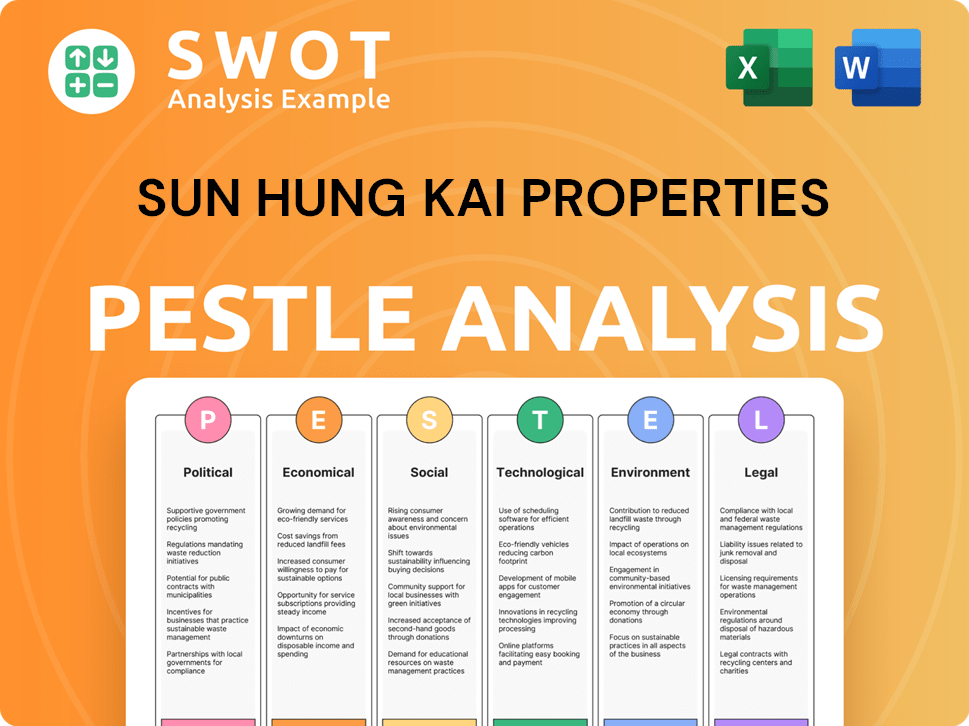
What are the key Milestones in Sun Hung Kai Properties history?
The history of Sun Hung Kai Properties (SHKP) is marked by significant achievements in Hong Kong real estate. The company's journey reflects its growth and impact on the urban landscape. The Kwok family has been central to the company's success.
| Year | Milestone |
|---|---|
| 1972 | Sun Hung Kai Properties was listed on the Hong Kong Stock Exchange, marking a significant step in its expansion. |
| 1980s | SHKP expanded its portfolio with the development of large-scale residential and commercial projects. |
| 2010 | The International Commerce Centre (ICC) was completed, becoming one of the tallest buildings globally and a symbol of SHKP's engineering prowess. |
| 2024 | SHKP continues to focus on sustainability, aiming for net-zero carbon emissions in its operations and new developments. |
SHKP has pioneered integrated property complexes, combining residential, commercial, and retail spaces with transport hubs. This approach creates self-contained communities, enhancing convenience for residents and tenants. Owners & Shareholders of Sun Hung Kai Properties have benefited from these innovative strategies.
SHKP's development of integrated property complexes, combining residential, commercial, and retail elements, sets it apart. These complexes often incorporate public transport hubs, creating convenient, self-contained communities.
The company has been at the forefront of sustainable building practices. This includes incorporating green technologies and energy-efficient designs into many of its new developments.
Sun Hung Kai Properties has faced challenges, including economic downturns and health crises. The Asian Financial Crisis and the SARS epidemic significantly impacted property values. More recently, social unrest and the COVID-19 pandemic affected the retail and hotel segments.
The Asian Financial Crisis in the late 1990s and the SARS epidemic in 2003 presented considerable market downturns, impacting property values and sales volumes. These events tested SHKP's resilience.
Social unrest in Hong Kong and the global COVID-19 pandemic have posed new hurdles, affecting retail and hotel segments. The company's retail portfolio experienced varying impacts during the pandemic.
Competitive threats from other major developers in Hong Kong and mainland China have necessitated continuous strategic adaptation. SHKP has responded through diversification and asset enhancement.
During the pandemic, SHKP's retail portfolio experienced varying levels of impact. The company has shown resilience in its recovery phase, demonstrating its adaptability to changing market conditions.
Sun Hung Kai Properties Business Model Canvas
- Complete 9-Block Business Model Canvas
- Effortlessly Communicate Your Business Strategy
- Investor-Ready BMC Format
- 100% Editable and Customizable
- Clear and Structured Layout
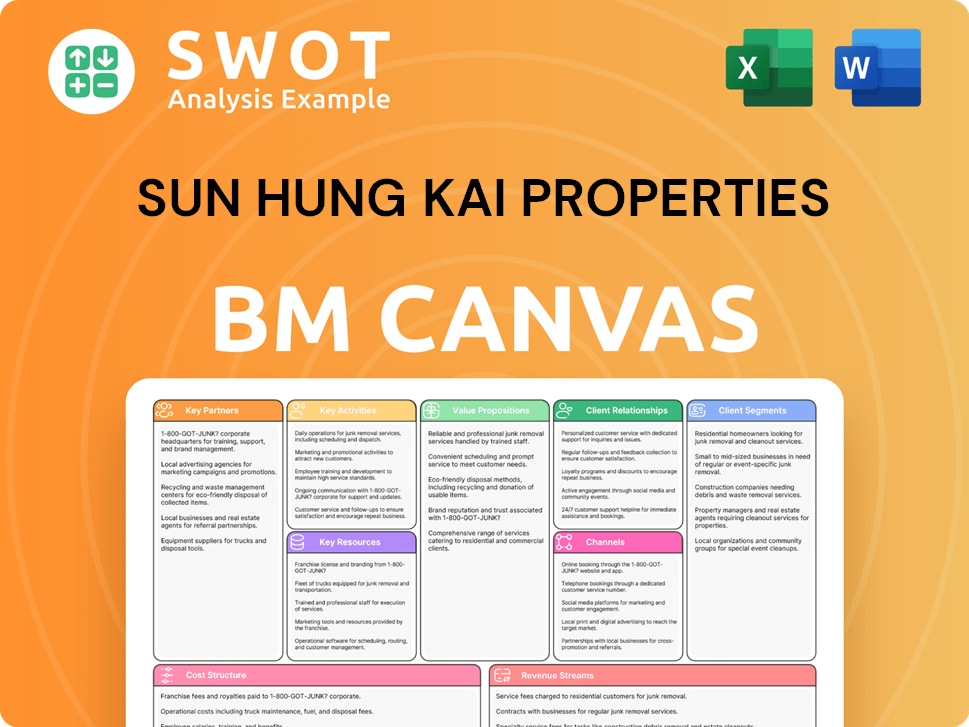
What is the Timeline of Key Events for Sun Hung Kai Properties?
Sun Hung Kai Properties' journey is marked by strategic milestones and significant expansions in the Hong Kong real estate market. From its incorporation in 1972 to its current status as a leading property developer, SHKP has consistently adapted to market changes while maintaining a strong focus on quality and innovation. The company's history reflects its ability to navigate economic cycles and embrace new technologies, ensuring its continued relevance in the dynamic property sector. Learn more about the Revenue Streams & Business Model of Sun Hung Kai Properties.
| Year | Key Event |
|---|---|
| 1972 | Sun Hung Kai Properties Limited is incorporated and listed on the Hong Kong Stock Exchange, marking the beginning of its journey in property development. |
| 1970s-1980s | SHKP expands rapidly in residential development across Hong Kong, establishing a strong market presence. |
| 1990s | The company diversifies into large-scale commercial and retail developments, including major shopping malls, to broaden its portfolio. |
| 1997 | SHKP faces challenges during the Asian Financial Crisis but demonstrates resilience through strategic adjustments and careful management. |
| 2000s | Focus shifts to developing iconic skyscrapers and integrated complexes, such as the International Finance Centre (IFC) in Central, enhancing its profile. |
| 2003 | SHKP navigates the impact of the SARS epidemic on the property market, showing adaptability and strategic foresight. |
| 2010 | The International Commerce Centre (ICC), a landmark skyscraper in West Kowloon, is completed, further solidifying its position in the market. |
| 2010s | Increased emphasis is placed on sustainable development and smart building technologies, reflecting a commitment to environmental responsibility. |
| 2019-2020 | SHKP confronts the impact of social unrest and the COVID-19 pandemic on its operations, demonstrating resilience and adaptability. |
| 2023-2025 | The company continues to focus on strategic land acquisitions, sustainable development, and expansion in mainland China, with a reported revenue of approximately HK$72.9 billion for the fiscal year ending June 2024. |
SHKP plans to expand its presence in mainland China, particularly in tier-one and strong tier-two cities. The company aims to capitalize on the increasing demand for high-quality residential and commercial properties in these markets. This strategic move aligns with their long-term growth objectives, leveraging their expertise in integrated property development. This expansion is expected to contribute significantly to the company's future revenue streams.
SHKP is committed to sustainable development, with ongoing efforts to reduce carbon emissions and incorporate green building practices. This includes investing in renewable energy sources and enhancing the energy efficiency of their properties. The company's focus on ESG (Environmental, Social, and Governance) factors is becoming increasingly important in the real estate sector. These initiatives are designed to meet the growing demand for environmentally friendly properties.
Industry trends such as urbanization, the growing demand for smart homes, and the increasing importance of ESG factors are likely to significantly impact SHKP's future. The company is well-positioned to leverage these trends, given its strong financial position and extensive land bank. SHKP's ability to adapt to market changes will be key to maintaining its leadership position in the property sector. These factors will drive future growth and profitability.
Analysts predict that SHKP will continue to leverage its strong financial position and extensive land bank to pursue new development opportunities. The company’s leadership has reiterated its commitment to delivering high-quality properties and services. This forward-looking approach, rooted in their founding vision of building quality properties for the community, ensures SHKP's continued relevance and success in the evolving real estate landscape. SHKP's financial strength supports its strategic initiatives.
Sun Hung Kai Properties Porter's Five Forces Analysis
- Covers All 5 Competitive Forces in Detail
- Structured for Consultants, Students, and Founders
- 100% Editable in Microsoft Word & Excel
- Instant Digital Download – Use Immediately
- Compatible with Mac & PC – Fully Unlocked
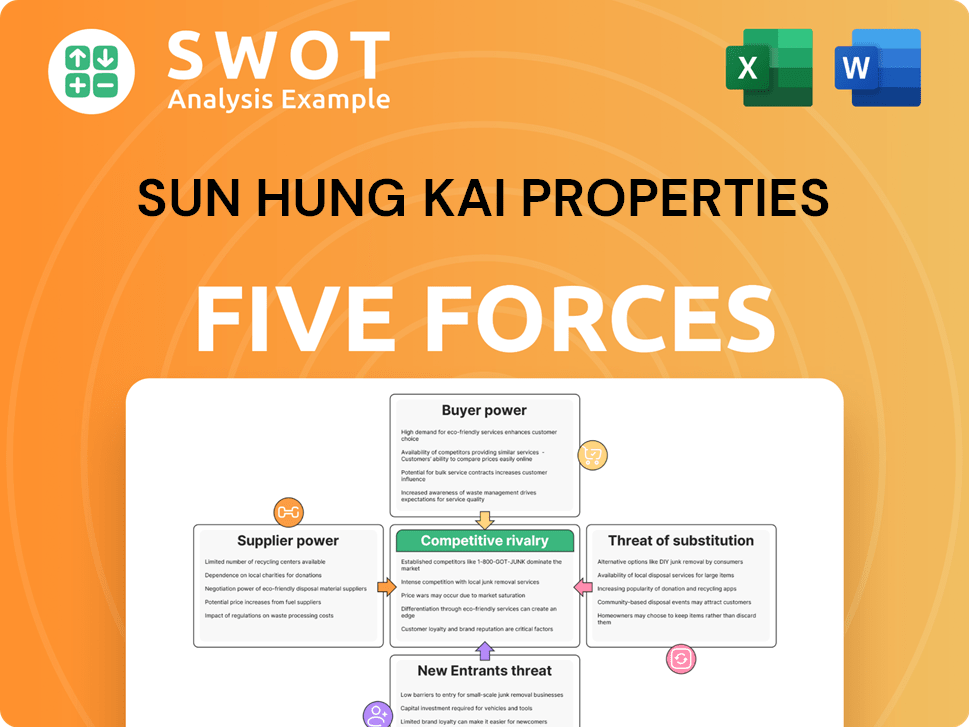
Related Blogs
- What is Competitive Landscape of Sun Hung Kai Properties Company?
- What is Growth Strategy and Future Prospects of Sun Hung Kai Properties Company?
- How Does Sun Hung Kai Properties Company Work?
- What is Sales and Marketing Strategy of Sun Hung Kai Properties Company?
- What is Brief History of Sun Hung Kai Properties Company?
- Who Owns Sun Hung Kai Properties Company?
- What is Customer Demographics and Target Market of Sun Hung Kai Properties Company?
Disclaimer
All information, articles, and product details provided on this website are for general informational and educational purposes only. We do not claim any ownership over, nor do we intend to infringe upon, any trademarks, copyrights, logos, brand names, or other intellectual property mentioned or depicted on this site. Such intellectual property remains the property of its respective owners, and any references here are made solely for identification or informational purposes, without implying any affiliation, endorsement, or partnership.
We make no representations or warranties, express or implied, regarding the accuracy, completeness, or suitability of any content or products presented. Nothing on this website should be construed as legal, tax, investment, financial, medical, or other professional advice. In addition, no part of this site—including articles or product references—constitutes a solicitation, recommendation, endorsement, advertisement, or offer to buy or sell any securities, franchises, or other financial instruments, particularly in jurisdictions where such activity would be unlawful.
All content is of a general nature and may not address the specific circumstances of any individual or entity. It is not a substitute for professional advice or services. Any actions you take based on the information provided here are strictly at your own risk. You accept full responsibility for any decisions or outcomes arising from your use of this website and agree to release us from any liability in connection with your use of, or reliance upon, the content or products found herein.